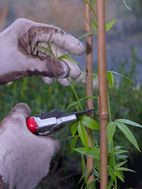- Shop Now
- Burncoose Specialities
- This Month
- Offers & Promotions
- RHS Chelsea Flower Show 2024
- 40 years at Burncoose
- Engage With Us
- Information, Help & Advice
- About Us & Our Services
- Terms & Conditions
- Log In / Register
Chapters
Passiflora - Care Guide
Caring for Passiflora
Passion Flower
There are hundreds of species of passiflora which originate mainly in tropical woodland in central and South America but also in tropical Asia, Australia and the Pacific. As this suggests, only a few species and varieties are suitable for growing outdoors in the UK. Most of the more exotic flowered species need a heated greenhouse where the temperature must remain above say 10°C for them to survive.
The name ‘passion flower’ is said to have been used originally by Spanish priests in South America because of the resemblance that their piety led them to detect between the various parts of the flower and the instruments of Christ’s Passion. The three stigmas representing the three nails, the five anthers the five wounds, the corona representing the crown of thorns or the halo and the ten tepals representing the apostles (Peter and Judas being absent).
Whatever the truth or otherwise of this assertion passion flowers are vigorous twining climbers with exotic and intricate flowers which have a wide tubular base, normally 10 tepals, which spread out flat or form a bowl shape. A stalk in the centre of each flower carries the ovaries and stamens and is surrounded by one or more rings of fleshy filaments; the corona. The fruits are rounded and usually yellow. Some are edible.
The following species and forms of passiflora are hardy enough to be grown outdoors in most of the UK. After a cold winter they may lose all their leaves but, once established with a thick woody stem, they will quickly reshoot in the spring and flower away for long periods through the summer and on into autumn. These are listed in declining order of hardiness:
P. caerulea, the blue passion flower, is far and away the toughest and easiest to grow on a hot wall or fence with some initial support for the long tendrils of new growth. The pure white flowered form, P. caerulea ‘Constance Elliot’, is equally hardy and grows with us through and over a large Camellia sasanqua on a west facing wall. The fruits are yellow to purple and not very flavoursome. This species can grow up to 30ft. It will produce root suckers and is easily propagated from softwood cuttings as are all passiflora species.
P. ‘Amethyst’ (P. ‘Lavender Lady’) is also a vigorous hardy climber with bowl shaped purple to purple-blue flowers, green anthers and darker corona filaments. In a mild winter with us it will normally retain some of its leaves. It can grow to 10-15ft and is normally improved by a good prune back in spring to encourage more flowering new growth.
P. x violacea (P. x caeruleoracemosa) has bowl shaped red-purple flowers with wide spreading corona filaments which are deep purple at the bases and white above. The fruits are rounded green and about 2in long. This passion flower will grow to around 20ft but, again, benefits from a spring prune. We also grow this on a wall and through an adjacent evergreen shrub.
P. antioquensis survives with us in a cold greenhouse where it has become established against a hot wall. After each winter it requires a hard pruning to remove the dieback which occurs in even a normal mild winter. The red banana passion flower has long rose red tubular flowers with small violet coronas and flowers mainly in the summer after hot periods. It is not a plant which can be grown outside even in Cornwall.
Sadly all the other more exotic flowering species do require heat to survive. P. quadrangularis with its huge pale to deep red flowers and massive coronas of wavy filaments goes dormant in one of our mist houses where there is some heat and will survive and usually reshoot from its chubby stem in the next season. P. edulis is a less reliable winter survivor in a similar situation and P. mollissima, the banana passion flower, with its yellow fruit seldom makes it through the winter although it is easy to propagate cuttings and overwinter them with bottom heat to overcome the problem. The lovely P. coccinea and P. racemosa usually join the dodo despite our best efforts.
To grow these lovely species you sadly therefore need more than a frost free greenhouse. Growing them under glass with heat does make all passion flowers prone to red spider mite, whitefly and mealy bug attacks. Where this occurs give the plant a good pruning back to bare stems and remove all dead leaves and stems which harbour these insects.
April Pruning
Lateral growths on Passion Flowers (Passiflora)can be cut back to 4”-6” from the main stems and will produce fresh young trails which will flower later.




















